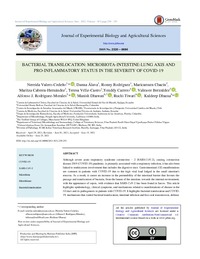Mostrar el registro sencillo de la publicación
Bacterial translocation: microbiota-intestine-lung axis and pro-inflammatory status in the severity of covid-19
| dc.contributor.author | Valero-Cedeño, Nereida | |
| dc.contributor.author | Álava, Danna | |
| dc.contributor.author | Rodríguez, Ronny | |
| dc.contributor.author | Chacín, Maricarmen | |
| dc.contributor.author | Cabrera-Hernández, Maritza | |
| dc.contributor.author | Véliz-Castro, Teresa | |
| dc.contributor.author | Carrero, Yenddy | |
| dc.contributor.author | Bermúdez, Valmore | |
| dc.contributor.author | Rodríguez-Morales, Alfonso J. | |
| dc.contributor.author | Dhawan, Manish | |
| dc.contributor.author | Tiwari, Ruchi | |
| dc.contributor.author | Dhama, Kuldeep | |
| dc.date.accessioned | 2022-07-08T18:17:07Z | |
| dc.date.available | 2022-07-08T18:17:07Z | |
| dc.date.issued | 2021 | |
| dc.identifier.uri | http://repositorio.ucm.cl/handle/ucm/3884 | |
| dc.description.abstract | Although severe acute respiratory syndrome coronavirus – 2 (SARS-CoV-2), causing coronavirus disease 2019 (COVID-19) pandemic, is primarily associated with a respiratory infection, it has also been linked to multisystem involvement that includes the digestive tract. Gastrointestinal (GI) manifestations are common in patients with COVID-19 due to the high viral load lodged in the small intestine's mucosa. As a result, it causes an increase in the permeability of the intestinal barrier that favours the passage and translocation of bacteria, from the lumen of the intestine, towards the internal environment, with the appearance of sepsis, with evidence that SARS-CoV-2 has been found in faeces. This article highlights epidemiology, clinical symptoms, and mechanisms related to manifestations of disease in the GI tract and its pathogenesis in patients with COVID-19. It highlights bacterial translocation and COVID-19, mechanisms that control bacterial translocation, intestinal infection and feco-oral transmission, defense mechanisms against microbial invasion, role of microbiota/microbiome and implications of their dysbiosis and alterations during SARS-CoV-2 infection, and lastly protective health benefits by improving dietary habits with nutritional foods approaches amid the ongoing pandemic. Increasing evidence indicates that bacterial translocation appears due to the high viral load of COVID-19 in the mucosa of the GI tract, and the intestinal microbiota contributes to the COVID-19 course owing to their bidirectional relationship with the immune system and lungs. Dysbiosis in gut microbiota leads to increased gut permeability thus predisposing to secondary infection and multiple organ dysfunction. Disruption of intestinal barrier integrity due to dysbiosis may cause translocation of SARS-CoV-2 from lungs into the intestinal lumen via the circulatory and lymphatic system, initiating severe clinical presentation of the infection. A thorough understanding of the key role of gut microbiota, gastrointestinal symptoms, and pathology along with immunomodulatory approaches would help in alleviating morbidity and mortality during the ongoing COVID-19 pandemic. | es_CL |
| dc.language.iso | en | es_CL |
| dc.rights | Atribución-NoComercial-SinDerivadas 3.0 Chile | * |
| dc.rights.uri | http://creativecommons.org/licenses/by-nc-nd/3.0/cl/ | * |
| dc.source | Journal of Experimental Biology and Agricultural Sciences, 9(3), 239-253 | es_CL |
| dc.subject | COVID-19 | es_CL |
| dc.subject | SARS-CoV-2 | es_CL |
| dc.subject | Microbiota | es_CL |
| dc.subject | Microbiome | es_CL |
| dc.subject | Bacterial translocation | es_CL |
| dc.subject | Gastrointestinal tract | es_CL |
| dc.subject | Immunomodulation | es_CL |
| dc.title | Bacterial translocation: microbiota-intestine-lung axis and pro-inflammatory status in the severity of covid-19 | es_CL |
| dc.type | Article | es_CL |
| dc.ucm.indexacion | Scopus | es_CL |
| dc.ucm.doi | doi.org/10.18006/2021.9(3).239.253 | es_CL |



